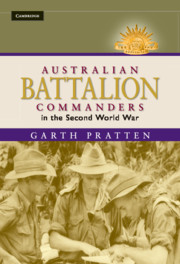Book contents
- Frontmatter
- Dedication
- Epigraph
- CONTENTS
- List of maps and figures
- Military symbols on maps
- ACKNOWLEDGEMENTS
- NOTES ON THE TEXT
- List of abbreviations
- INTRODUCTION
- CHAPTER 1 ‘COMPLETELY UNTRAINED FOR WAR’
- CHAPTER 2 THE FOUNDATIONS OF BATTALION COMMAND
- 3 ‘WE WERE LEARNING THEN’
- CHAPTER 4 DESERT EPILOGUE
- CHAPTER 5 VICTIMS OF CIRCUMSTANCE
- CHAPTER 6 ‘NO PLACE FOR HALF-HEARTED MEASURES’
- CHAPTER 7 ‘THERE IS NO MYSTERY IN JUNGLE FIGHTING’
- CHAPTER 8 ‘EXPERIENCED, TOUGHENED, COMPETENT’
- CONCLUSION
- APPENDIX 1 THE DEMOGRAPHICS OF AUSTRALIAN BATTALION COMMANDERS
- APPENDIX 2 PERIODS OF COMMAND
- NOTES
- BIBLIOGRAPHY
- INDEX
CHAPTER 1 - ‘COMPLETELY UNTRAINED FOR WAR’
Battalion command in the pre-war army
Published online by Cambridge University Press: 18 December 2014
- Frontmatter
- Dedication
- Epigraph
- CONTENTS
- List of maps and figures
- Military symbols on maps
- ACKNOWLEDGEMENTS
- NOTES ON THE TEXT
- List of abbreviations
- INTRODUCTION
- CHAPTER 1 ‘COMPLETELY UNTRAINED FOR WAR’
- CHAPTER 2 THE FOUNDATIONS OF BATTALION COMMAND
- 3 ‘WE WERE LEARNING THEN’
- CHAPTER 4 DESERT EPILOGUE
- CHAPTER 5 VICTIMS OF CIRCUMSTANCE
- CHAPTER 6 ‘NO PLACE FOR HALF-HEARTED MEASURES’
- CHAPTER 7 ‘THERE IS NO MYSTERY IN JUNGLE FIGHTING’
- CHAPTER 8 ‘EXPERIENCED, TOUGHENED, COMPETENT’
- CONCLUSION
- APPENDIX 1 THE DEMOGRAPHICS OF AUSTRALIAN BATTALION COMMANDERS
- APPENDIX 2 PERIODS OF COMMAND
- NOTES
- BIBLIOGRAPHY
- INDEX
Summary
On the eve of the Second World War the AMF was an obsolescent organisation unfitted for modern war. The experience of the First World War dominated its doctrine and ethos, and its structure and organisation replicated that of the Australian Imperial Force (AIF), which had been formed in 1914, specifically for war service, and disbanded in 1921. Yet the AMF of 1939 fell far short of the AIF’s standards of proficiency. The AMF was predominantly a part-time force, and its regular component, known as the Permanent Military Forces (PMF), comprised only 7 per cent of its strength. The vast majority of its combatant units, including all infantry battalions, were drawn from the part-time component, known as the militia. The militia consistently failed to meet recruiting targets between 1930 and 1938, and part-time training, coupled with poor retention, produced skeleton units of partly trained soldiers. The financial stringency of the Depression years also resulted in a force devoid of modern weapons, transport and signals equipment.
In 1939 most of the AMF’s commanders, down to battalion level, were ageing veterans of the First World War. They represented the only significant pool of operational experience in the AMF and accordingly were valued highly. Even in the late 1930s, active service in the First World War remained a prerequisite for an appointment to a battalion command. This might have been a sound practice in the 1920s but, in the light of developments in military tactics and technology occurring overseas, in the mid- to late 1930s it served only to perpetuate the AMF’s obsolescence. It also served to create a generation of battalion commanders whose physical and mental fitness to command in time of war was questionable and to block the development of a larger pool of younger, more adaptable officers.
- Type
- Chapter
- Information
- Australian Battalion Commanders in the Second World War , pp. 30 - 47Publisher: Cambridge University PressPrint publication year: 2009



